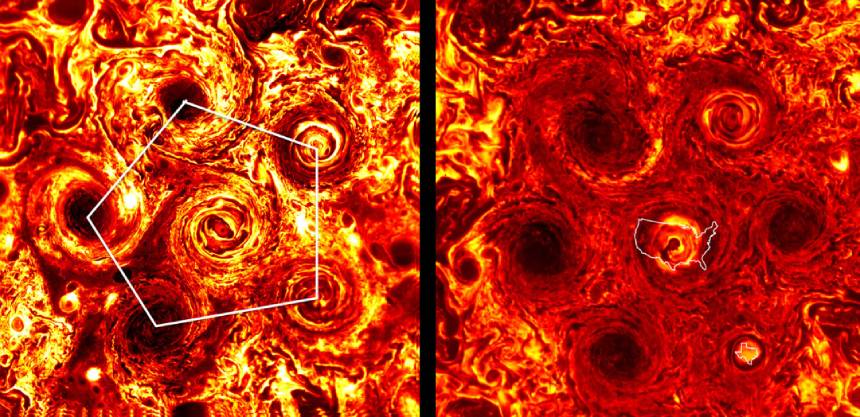Recently, some scientists from the United States, Italy and France have tried to use the “shallow water model” to decipher the polygonal storm array captured by Juno probe on Jupiter’s north and south poles. It turns out that while the model can partially explain why these storms have been around for so long, it brings up a bigger mystery. NASA’s Juno probe entered a polar orbit, orbiting Jupiter in a direction perpendicular to Jupiter’s equator. With the transmission of photos, scientists found that Jupiter’s south pole is actually a pentagon, and the north pole is an octagon, which is very similar to the “gossip map” in traditional Chinese culture. It was also found that these two polygons are very stable, and the storms that make up them still exist today, and even the shape has not changed much.
This is an incredible phenomenon. According to Earth’s experience, storms are unstable and can only last for a short time before dissipating. But these polar storms, far away on Jupiter, are eerily stable. By analyzing the photos of Jupiter’s north and south poles taken by “juno”, some characteristics can be found: each of the two polygons has a central storm, and this central storm is located just above Jupiter’s north and south poles. The relationship between all adjacent outer storms, and between all outer storms and the central storm, is basically equidistant. What the new study seeks to explain is why these polygonal storms persist for so long, and how they do so without changing their shape and relative position.

The researchers started with wind speed and direction and built a “shallow water model” based on all the data. Based on the models, the researchers deduced the existence of an “anticyclonic ring” around these storms, with winds in the ring in the opposite direction of the storm’s rotation. This allows the storm to remain stable for long periods of time. But at the same time researchers found no sign of convection near these storms. Convection is the source of heat for a storm, and without it, a storm is unsustainable. So while the storm has been extensively studied, its nature presents a formidable challenge to planetary scientists. It has now been concluded that the exact mechanism of this interaction requires further study to be fully understood.
